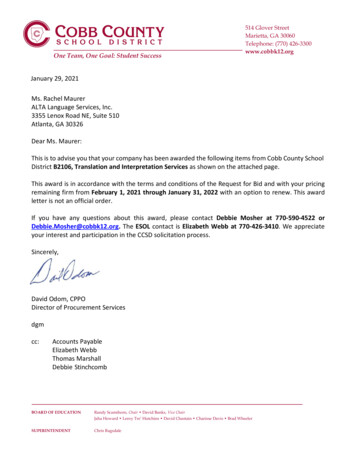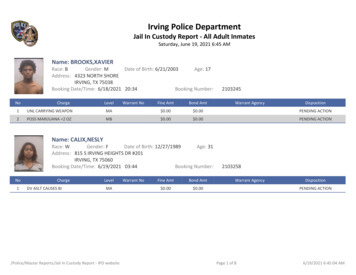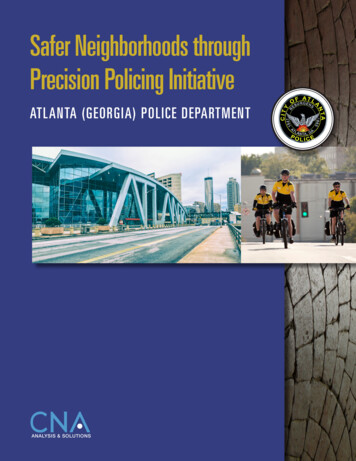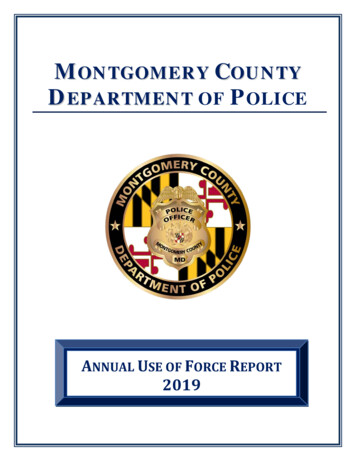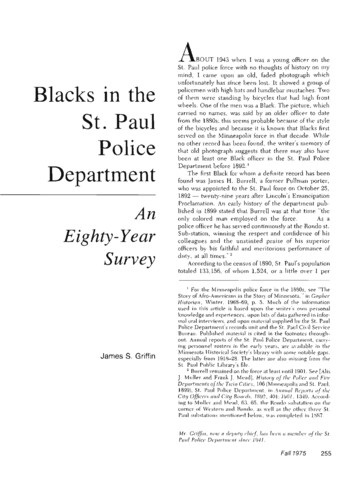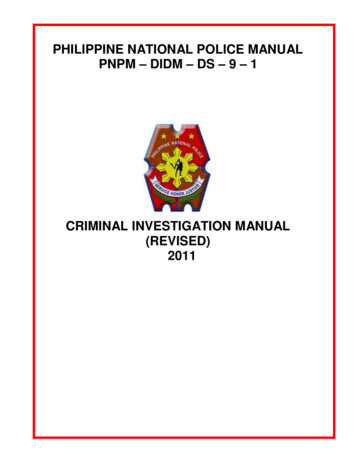
Transcription
The Marietta Police Department:How They Made Jiu Jitsu MandatorySpecial Thanks to Major Jake King, Clay Culpepper and Chief Dan Flynn2021The following information was sent to Invictus Leo Jiu Jitsu Collective by Major King about theprocess the Marietta Police Department went through to get Jiu Jitsu mandatory at theiragency.Permission to use the following information to help your department granted.Compiled by: Invictus Leo Jiu Jitsu Collective
THE PROPOSAL
Marietta Police Department240 Lemon Street, Marietta, Georgia 30060 Telephone 770-794-5300 Fax 770-794-5301Dan Flynn, Chief of PoliceCity of Marietta Police four-month trial training offer for Borges BJJ and FitnessFebruary 28th, 2020The City of Marietta Police Department would like to offer a four-month trial for all swornofficers to train at Borges BJJ and Fitness. We recognize the benefits of learning control tacticsfor every officer and have the below offer for the next four months ending July 1 st, 2020. AfterJuly 1st, both parties will discuss a long-term agreement to include the standard price of amonthly membership based on the number of officers participating in the program.Four-month trail offer: Daily rate be agreed upon at 10.00 per visit for all sworn officersOfficers may train up to three times a week and that amount will be coveredOfficers are responsible for purchasing their own training GiOfficers will be compensated for training timeOfficers MUST sign in on department roster and Borges BJJ cardsOfficers will attend an orientation conducted by police department staff prior toparticipating in the programThank you for considering this offer,Major Jake King
A Message from Chief FlynnBrazilian Jiu-Jitsu: The future of policingBy Chief Dan FlynnAny serious discussion of the need for police reform or improvement ultimately boils down topolice use of force. While few doubt that the police will always need to subdue combative people,i.e., criminals trying to escape, excited individuals high on drugs or alcohol, andmentally/behaviorally ill individuals suffering psychotic episodes; the American public has littleappetite for watching images of police officers striking, kicking or even the use of profanity! Infact, many average citizens see police use of force as lawful, but awful.Traditional police use of force tactics basically prescribe justified ways for the police to beatcombatants into submission using pain compliance, striking, and blunt force techniques that willnever look good; particularly on camera or video. Thus, for those responsible for police policyand training, who concede that the police need a better way to overcome combative activeresistance, there is a growing interest in Brazilian Jiu-Jitsu.Jiu-Jitsu is a Japanese term that translates into “gentle art.” Relying on self-disciplined leverage,weight and special control tactics to subdue combative suspects without beating them intosubmission. Whereas traditional police use of force techniques rely on striking and the use ofwrist and arm locks, Jiu-Jitsu relies on leveraging the officer’s body weight to control thecombatant’s torso and hips. It uses neither boxing nor wrestling techniques, but rather weightand leverage control techniques to take someone to the ground and control them once they areon the ground without using blunt force or striking them. It also teaches the officer techniquesfor escaping the clutches of an attacker, avoiding being struck themselves, and using space tohis/her advantage.In the decades of the evolution of police use of force, serious police policy makers and trainershave been striving to find better methods for subduing combatants using less violence andbrutality. Over time, height and size requirements for officers, blackjacks, batons, and largemulti-battery flashlights have given way to more effective and less injurious electronic weapons.Hand to hand combat solutions are also being reduced by crisis intervention and de-escalationtraining, but the need to go hands-on will never go away completely. Indeed, the vital work ofpolicing is not changing, but the economics and public perceptions of it are changing, as theyhave been for decades.As emerging police leaders confront the challenges of change, we need to look for opportunitiesto improve in terms that are palatable to all. Considering the feasibility of incorporating andtraining in the application of the martial arts, like Jiu-Jitsu, is an idea whose time has come.Chief Dan Flynn
The Data and Stats:MARIETTA POLICE DEPARTMENTBJJ Training Program – Data SummaryOn April 1, 2019, Marietta Police Department (MPD) instituted a training program that madeweekly Brazilian Jiu-Jitsu (BJJ) training mandatory for all new hires during the five months theywere in the police academy. The training took place at a carefully vetted civilian owned/operatedBJJ academy (Borges BJJ in Marietta) within the community. The program was so successful that onJuly 1, 2020, we extended the department-sponsored BJJ training opportunity to all in-serviceofficers. To date, 95 of the 145 sworn MPD officers opted in to the BJJ program. Here is asummary of the data collected thus far:Training Injuries MPD has had 95 officers attend over 2,600 civilian-operated BJJ classes with one (1)reported training injury, a broken nose.Taser Deployments Since the inception of the program, non-BJJ officers used their Taser in 77% of UOF incidents. BJJ officers used their Taser in 54% of UOF incidents (85% of which were used to stop afoot pursuit – not to end the physical altercation) 23% reduction in Taser deployments.UOF Injuries to Officers In the 18 months prior to instituting mandatory BJJ training, 29 officers were injuredwhile carrying out arrests. In the 18 months after instituting mandatory BJJ training for new hires, 15 officers wereinjured while carrying out arrests. 48% reduction in officers’ injuries. None of the injured officers were enrolled in the BJJ program. Based on an average workers’ comp claim of 4,768, the total savings from the reductionin officer injuries is estimated at 66,752.UOF Injuries to Suspects In 2020, there were 33 UOF incidents involving Marietta PD officers: 20 incidents involvingnon- BJJ officers, and 13 incidents involving BJJ-trained officers (classified as officers whoparticipated in at least (1) off-duty BJJ class per week). In the 20 incidents involving non-BJJ officers, the suspect sustained injuriesrequiring medical clearance 65% of the time (13 incidents of suspecthospitalization). In the 13 incidents involving BJJ-trained officers, the suspect sustained injuriesrequiring medical clearance 31% of the time (4 incidents of suspect hospitalization).
The suspect is more than twice as likely to be required medical clearance/hospitalizationin a UOF encounter with a non-BJJ officer than with a BJJ-trained officer.53% reduction in serious injuries to suspects.In 2019, our nightshift was responsible for 44% of the departments UOF and only one BJJofficer was assigned to the shift. In 2020, 75% of the officers on night shift were BJJpractitioners and the total number of UOF was reduced by 18%The Policy at the Marietta Police Department Re: BJJMARIETTA POLICE DEPARTMENTSTANDARD OPERATING PROCEDURESUBJECTEFFECTIVE DATESOP #Brazilian Jiu Jitsu TrainingPendingT060REFERENCE Advanced Training, Field Training Program, Use of Force, Health & WellnessSPECIAL INSTRUCTIONSDISTRIBUTIONAll Sworn Personnel, Public SafetyAmbassadors & Prisoner Transport Officers# PAGESXXI.PURPOSEThe purpose of this policy is to mandate Brazilian Jiu Jitsu training for all new officersand encourage additional training for solo officers. Brazilian Jiu Jitsu teaches methods tocontrol a suspect and restrain them in various positions which reduces the risk of injuryto the suspect as well as to the officer. This training will also benefit the physical fitnessof officers and applicable civilian personnel.II.POLICYIt is the policy of the Marietta Police Department to provide personnel with additionalBrazilian Jiu Jitsu training to accommodate the ever-increasing demands of the lawenforcement profession. This policy shall apply to all sworn personnel, prisonertransport officers and public safety ambassadors.III.PROCEDURESA.The department will provide all sworn personnel, public safety ambassadors andprisoner transport officers with Brazilian Jiu Jitsu (BJJ) training at a facilityapproved and designated by the Chief of Police or designee.
B.Newly hired police officers will be required to attend BJJ Training at a minimumof once a week for an hour effective from the date of hire until the officer beginsthe field training program. Recruits are eligible to receive up to three hours ofcompensatory time (CT) per week for BJJ training at the approved facility;however, there is not a limit on BJJ training hours. Any missed mandatorytraining must be approved by the Training Unit. Recruits will receive P.O.S.T.credit for attendance.C.Once the officer enters the field training program or achieves solo status he orshe may voluntarily attend BJJ training on or off duty for P.O.S.T. credit. Officersmay accrue up to three hours of CT per week; however, there is not a limit on BJJtraining hours at the approved facility.D.Public Safety Ambassadors and Prisoner Transport Officers may also attend BJJTraining on or off duty at the approved facility; however, attendance is notmandatory. PSAs and PTOs may accrue up to three hours of CT per week.E.All personnel must sign in when attending training at the approved BJJ facility.The Training Unit will maintain the training logs and enter the training hours forP.O.S.T. credit.F.BJJ training on duty requires the approval of supervision which may beinfluenced by factors including, but not limited to, manpower and call volume.G.Personnel must wear the facility’s approved apparel during a training session.Recruits are provided this apparel by the city when hired; however, solo officers,PSAs and PTOs are responsible for obtaining this apparel themselves.H.Any injuries sustained during BJJ training, whether on or off duty, will be coveredby the City of Marietta’s Worker’s Compensation. Any injuries during BJJ trainingmust immediately be reported to supervision and follow the First Report ofInjury protocol as outlined in A019 (Risk Analysis).E.BJJ training is a supplement to yearly required Defensive Tactics training and isnot considered to be a substitution.Dan Flynn, Chief of Police
Teaching Defensive Tactics in the 21st CenturyHow the Marietta, Ga. Police Department made Brazilian Jiu Jitsu Mandatoryby Major Jake King and Sergeant Clayton CulpepperPolice officers’ conduct today is under greater scrutiny than ever. This is especiallytrue when officers must respond to a suspect’s aggressive behavior when makingan arrest. Generally, the public does not understand the complexities associatedwith these rapidly evolving situations. The problem is compounded when thenarrative accompanying these video recordings is less than objective. Punches andbaton strikes may be legal and justified by a use of force policy, but the public oftenview these actions as excessive. Because of this, it is imperative police leadersregularly evaluate their officers’ use of force policy and training.The Marietta Police Department has been working on how to better respond toaggressive individuals for more than 10 years. As part of this initiative, new recruitsare required to complete de-escalation training and Crisis Intervention Training(CIT). They also began teaching officers Brazilian Jiu Jitsu (BJJ) control techniques.Jiu Jitsu, which can be translated as the ‘gentle art’, has gained popularity acrossthe United States in the last 30 years as well as acceptance by law enforcementagencies as an effective, non-deadly, use of force technique. BJJ is a grapplingtechnique based on simple movements and body positioning that enables anofficer to effectively control and restrain a suspect in a variety of positions. SinceBJJ does not require extensive training to perform complex movements, it can beeasily taught to anyone, regardless of the officer’s size, strength or fitness level.Essentially, officers are trained in the gentle art of controlling persons who areresisting with the added benefit of reduced risk of injury to the officers or thesuspect.After BJJ was introduced to the Marietta police department, instructors proposedto make the training mandatory for new recruits. As with most agencies, thedepartment’s defensive tactics instructors have multiple responsibilities thatprevent them from taking on additional assignments. In order to implement theproposed mandatory training, instructors recognized the proposal had to bereasonable, sustainable, and affordable. If any of the three factors were missing,the proposal would fail.
Offering more classes or having additional open mat sessions was not an acceptablealternative. By going outside the agency for instruction, officers could train with BJJexperts at varying hours, providing greater flexibility in the training schedulewithout putting additional pressure on department instructors. After consultingwith several facilities, the agency entered an agreement with a local gym to providenine classes a week that included morning, afternoon, and evening sessions as wellas on Saturday mornings. This schedule provided officers considerable flexibility toattend class.To fund the project, the training had to be affordable. Currently, the departmentaverages between four and ten recruits in the program at one time, so the trainingcosts fluctuate monthly. Every gym has a “drop-in” or daily rate. As part of thenegotiations, the department was able to reach an agreement with the gym thatwas within the allocated training budget. As a result, the department has been ableto train its recruits in the best martial arts in the world for law enforcement for afew hundred dollars a month.All recruits are r
Jiu-Jitsu is a Japanese term that translates into “gentle art.” Relying on self-disciplined leverage, weight and special control tactics to subdue combative suspects without beating them into submission. Whereas traditional police use of force techniques rely on striking and the use of wrist and arm locks, Jiu-Jitsu relies on leveraging the officer’s body weight to control the combatant .
